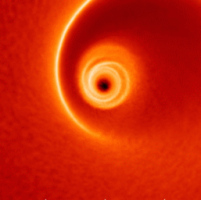|
| General Relativistic simulations show that the final coalescence of black hole binaries typically results in a kick or recoil of the merged black hole away from the center of mass of the pre-merger binary. The kick - which arises because gravitational waves carry away linear momentum - can have a magnitude of several thousands of km / s, although smaller values of the order of a few hundred km / s may be more typical. These kicks are of particular interest for supermassive black hole binaries that merge within gaseous disks. The kick will perturb the surrounding gas, and this can result in an electromagnetic signature of the merger process. Electromagnetic counterparts - if they exist - would be important for a variety of reasons, not least since they would allow localization of mergers that could otherwise be detected only via their gravitational wave emission. The animations on this page show how a geometrically thin circumbinary accretion disk responds to a kick following the merger of a supermassive black hole binary. |

|
Kick at an arbitrary angle (here 60 degrees) to the disk plane
The response of the gas disk to a kick directed at an angle of 60 degrees from the disk plane. Unlike the two cases shown above this is a fully three-dimensional problem, but it shares many of the features of the special cases. In particular, accretion is very important for kicks directed close to the disk plane, but less important for kicks that are close to perpendicular. Computed using SPH, and visualized using SPLASH. Click on the image to view a movie in Quicktime format. |
|
|
|